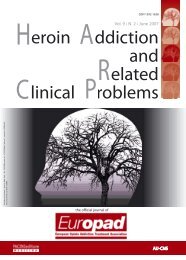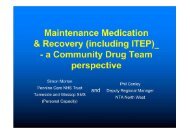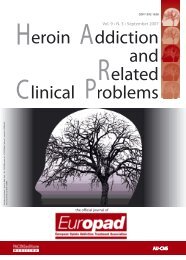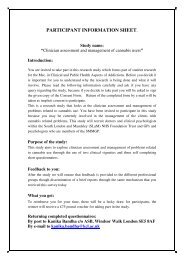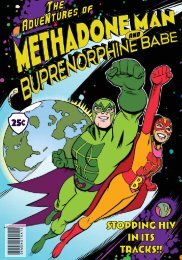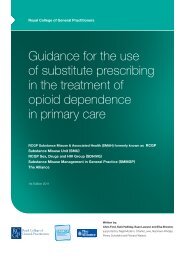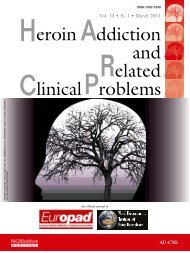cocaine guidance - Royal College of General Practitioners
cocaine guidance - Royal College of General Practitioners
cocaine guidance - Royal College of General Practitioners
- No tags were found...
You also want an ePaper? Increase the reach of your titles
YUMPU automatically turns print PDFs into web optimized ePapers that Google loves.
23Appendix 4Pipe smokers (pipers)■ Always use your own pipe and never share pipes,to avoid virus transmission.■ If using plastic bottles or cans, advise switching toglass pipes, to avoid inhaling ash, paint, dust, waterand other particles into the lungs.■ Encourage the purchase <strong>of</strong> a glass pipe (found insome tobacco shops). Explain that glass pipes arehealthier as they permit less damaging particles topass into the lungs and can be cleaned betweensessions.■ If glass pipes are not available, adapt a miniature spiritbottle that has a dimple in the end, in which a holeis made. A metal tube such as a car aerial is placedin the neck <strong>of</strong> the bottle, wire gauze is placed in theexposed end <strong>of</strong> the tube and crack is placed onthe gauze. The drug is smoked through the hole inthe dimple. 5■ To avoid contaminants always use wire gauze inthe vent, not scouring pads.■ Promote ‘ash free’ pipes and smoking techniques.■ Encourage the move towards non-injecting routes<strong>of</strong> use such as chasing.Injectors■ Advise users to ensure they have sufficient amounts<strong>of</strong> injecting equipment – ‘one kit for every hit.’■ Make sure <strong>cocaine</strong> injectors realise they need moreinjecting equipment than heroin users.■ Advise them about the way <strong>cocaine</strong> tends toanaesthetise the injection site leading to tissuedamage and increased risk <strong>of</strong> abscesses frommissing the vein.■ Check injecting sites and promote safer sites on thearms and legs. Explain the damage caused by <strong>cocaine</strong>injecting, and why there is a quicker transition to groinor neck injecting and the associated dangers.■ Try to promote switching to a non-injecting route,such as piping.■ Inform them that overdose is most <strong>of</strong>ten linked toinjection, so always use in a group where otherscan watch for signs <strong>of</strong> overdose.Overdose■ Most common with injecting. Signs develop rapidlywithin 2 to 3 hours.■ Understand the signs <strong>of</strong> overdose:Smoking using cigarettes or joints (chippers)■ Use unbleached card to make filters, to avoid breathingin harmful substances on the card.■ Advise the user to work out how much they areactually using – may not be as little as they think.■ Be cautious whom you pass the joint to – some maynot realise it contains <strong>cocaine</strong>.Burning on foil (chasers)■ Advise people to chase more effectively by burningthe foil, placing the crack on it and inhaling the smokethrough a tube as you burn the crack with a lighterunder the foil.■ Break up the rock a little before burning and don’tput too much drug on the foil.■ Explaining effective chasing is important, to preventusers from switching to injecting or some other methodin order to get more effect from their drugs.■ Use tinfoil and not foil from sweet packaging whichis <strong>of</strong>ten covered with contaminants.■ Mild to moderate signs are: restlessness, pressuredspeech, behavioural change, sudden rise in bodytemperature, flushed face, hot skin, muscle cramps,stiffness in arms and legs.■ Severe cases signs are: unresponsive to stimuli,arrythmias, circulation and respiratory collapse,hypertension, tachycardia, fever, increased motoractivity, seizures and confusion.■ Advise the drug user to call for an ambulance early,rather than wait until the situation is critical.■ Management while awaiting the ambulance is tocheck the airway and breathing, try to control thetemperature with fans etc and manage any seizures.■ In hospital the management would be to sedate,usually with benzodiazepines, control seizures,treat any cardiac complications, control blood pressureand temperature and ensure intravenous access andcorrect any electrolyte imbalance.■ Increased risk with speed-balling or when user is incustody and has swallowed large amounts to avoidpolice detection.



